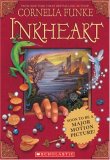Summary | Excerpt | Reading Guide | Reviews | Beyond the Book | Read-Alikes | Genres & Themes | Author Bio

In a book club? Subscribe to our Book Club Newsletter!
Please be aware that this discussion guide will contain spoilers!
Setting
Theme
Books Mentioned in Inkheart
1001 Arabian Nights (Oxford Story Collections), retold
by Geraldine McCaughrean. Oxford, 2000.
These stories told by the wily Shaharazad to save her life are
full of adventure, treasure, magic, and heroism.
Barrie, Sir James Matthew. Peter Pan. (Scholastic
Classics) Scholastic, 2002.
Peter Pan, aided by his companion Tinker Bell, is the leader of
the Lost Boys in Neverland who battle the wicked Captain Hook and
his pirates.
Ende, Michael. The Neverending Story. Puffin, 1996.
Bastian Balthazar Bux enters the enchanted world of Fantastica
through the pages of an ancient and mysterious book to rescue the
fairy people who live there.
Goldman, William. The Princess Bride. Ballantine, 1990.
A story of love, hatred, giants, dwarves, courage, cowardice,
revenge, escape, truth, lies, fantastical beasts, and a satisfying
end.
Silverstein, Shel. Where the Sidewalk Ends: Poems and
Drawings. HarperCollins, 1974.
Silverstein's poems about everything from unicorns to television
sets are characterized by sly humor and insight that have
delighted countless readers.
Stevenson, Robert Louis. Treasure Island (Scholastic
Classics) Scholastic, 2001. This classic tale of Jim Hawkins' adventures on the high seas with
the villainous Long John Silver has been a favorite of many
generations.
White, T. H. The Sword in the Stone, illus by Dennis
Nolan. Philomel, 1993. Merlin oversees the education of the Wart, who will grow up to
become Arthur, the Once and Future King of Britain.
Related Reading
Crossley-Holland, Kevin. The Seeing Stone. Scholastic,
2001.
A boy named Arthur, living in 13th century England,
watches a story unfolding in a magic stone — the story of the
birth and growth of his namesake, the great legendary King of
Britain. His story continues in At the Crossing Places
(Scholastic, 2002).
Mahy, Margaret. The Great Piratical Rumbustification & the
Librarian and the Robbers. David R. Godine, 2001.
Imagine having a gang of pirates as your babysitters or a
librarian who can charm bloodthirsty bandits by reading aloud to
them.
Sanvoisin, Eric. The Ink Drinker. Delacorte, 1998
A boy watches a weird man in his father's bookstore silently
sipping the words out of the books; following him to a nearby
graveyard, he discovers that the ghoulish stranger is a vampire
who lives on ink rather than blood.
Townley, Roderick. The Great Good Thing. Atheneum,
2001.
12 year old Princess Sylvie breaks out of the book in which she is
a character and into the dreams of her Reader, leading other
characters to a new existence where they have to make up their own
story, and remind the girl who loves them of the importance of
their story.
Discussion guide written by Connie Rockman, children's
literature consultant and adjunct professor of literature for
children and young adults at the University of Bridgeport and
Sacred Heart University, and editor of The Eighth Book of
Junior Authors and Illustrators (H. W. Wilson, 2000).
Reproduced with the permission of Scholastic Books.
Unless otherwise stated, this discussion guide is reprinted with the permission of Scholastic. Any page references refer to a USA edition of the book, usually the trade paperback version, and may vary in other editions.
Your guide toexceptional books
BookBrowse seeks out and recommends the best in contemporary fiction and nonfiction—books that not only engage and entertain but also deepen our understanding of ourselves and the world around us.